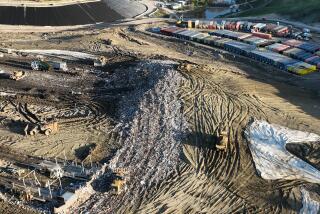Plant Closings Tied to Dumps : 50% of Landfills Cannot Meet Deadline, EPA Says
WASHINGTON â Factories owned by some of Americaâs biggest companies could be forced to close temporarily if the toxic waste dumps they use miss a November deadline for complying with federal pollution laws, a top Environmental Protection Agency official told a House subcommittee Monday.
And nearly half the nationâs largest toxic waste dumps--including many vital to the operations of major industries--apparently will miss that deadline and face federally ordered shutdowns, the EPA announced.
In daylong hearings on waste disposal rules, Gene Lucero, the EPAâs chief toxic waste law enforcer, estimated that as many as half of the 1,450 federally licensed landfills and waste lagoons are technically unable to meet a congressionally imposed deadline of Nov. 8 for complying with anti-pollution regulations.
The threatened dumps include a few of the nationâs 58 commercially operated toxic waste sites, but most are privately operated lagoons and landfills on factory grounds. Their closure would create an âimmense problemâ in finding safe disposal sites for industrial wastes, Lucero said.
âThey include a lot of major companies in this country--Ford, GM, Dow Chemical--and they may have to stop operationsâ until legal waste disposal sites can be found for factory wastes, he said. âWe would like you to grasp the fact that this (deadline) is going to have a tremendous impact.â
But that drew a sharp response from some legislators, who accused the EPA of failing to promptly enforce the pollution laws in the first place.
âWeâre not going to let you shift responsibility over to Congress,â Rep. James J. Florio (D-N. J.) said. âIt is only because we find not too terribly much has been done that something has had to be forced. You (EPA) should have closed these places down in 1981.â
Congress set the November compliance date last fall after learning that hundreds of dump operators had effectively ignored provisions of the 1976 Resource Conservation and Recovery Act, the nationâs primary toxic-dump law. The law required dump owners to meet financial standards and install sophisticated leak-detection systems on their grounds by November, 1981, but fewer than half of all dump and lagoon operators have met those standards.
Easing of Rules Weighed
Under often harsh questioning from subcommittee legislators, Lucero said that the EPA is considering regulations that would allow at least some of the non-complying dump and lagoon owners to continue operations until they could meet the standards.
Otherwise, Lucero warned, the shortage of legal waste disposal sites also could curb the cleanup of abandoned dumps under the federal Superfund program. Superfund wastes have frequently been hauled to commercial landfills for reburial but some of those landfills cannot meet the November deadline either, he said.
Unsympathetic legislators noted that the non-complying dumps are owned by major corporations that already have had five yearsâ warning to meet federal standards.
Lucero was one of several EPA officials blistered by the subcommittee for failing to enforce the 1976 law and regulations governing toxic-dump safety. For more than an hour, the legislators grilled officials of the EPAâs southern and western regions about their apparent ignorance of what one called âegregiousâ pollution at federally licensed dumps.
âNightmareâ in California
In one case, an EPA official blamed an âadministrative nightmareâ in California state government for failure to detect or control leaks at Kettleman Hills, a huge toxic dump off Interstate 5 in Kings County.
The EPA found that Kettleman Hills had failed to comply with leak-detection requirements in April, 1983, about 18 months after a federal deadline to install monitoring wells on the site. Not until 15 months later was the landfill operator cited for the violation. The site since has been found to leak cancer-causing chemicals into underground water.
Harry Seraydarian, an EPA toxic waste official based in San Francisco, said that he had given California regulators âthe first opportunityâ to cite the dumpâs operators but that overlapping state bureaucracies kept the state from acting.
More to Read
Sign up for Essential California
The most important California stories and recommendations in your inbox every morning.
You may occasionally receive promotional content from the Los Angeles Times.










